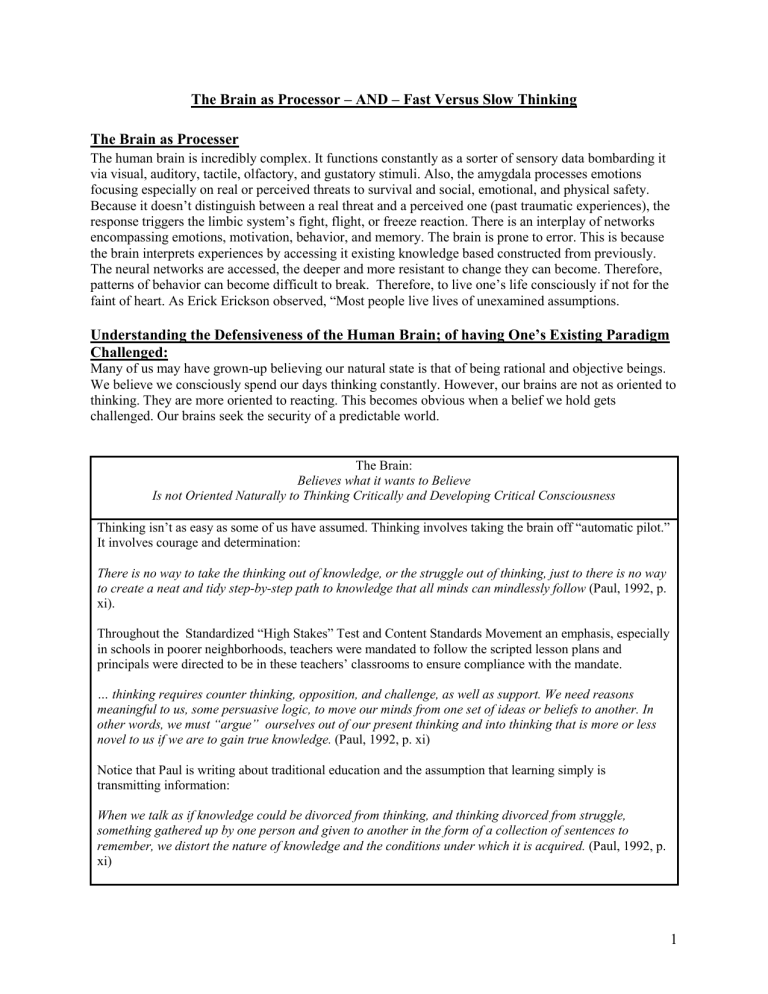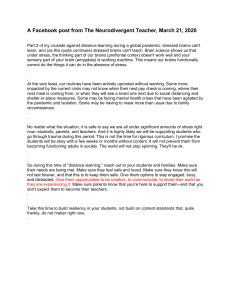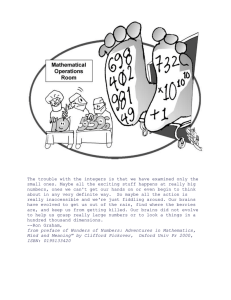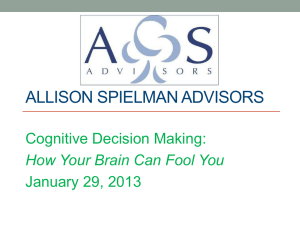
The Brain as Processor – AND – Fast Versus Slow Thinking The Brain as Processer The human brain is incredibly complex. It functions constantly as a sorter of sensory data bombarding it via visual, auditory, tactile, olfactory, and gustatory stimuli. Also, the amygdala processes emotions focusing especially on real or perceived threats to survival and social, emotional, and physical safety. Because it doesn’t distinguish between a real threat and a perceived one (past traumatic experiences), the response triggers the limbic system’s fight, flight, or freeze reaction. There is an interplay of networks encompassing emotions, motivation, behavior, and memory. The brain is prone to error. This is because the brain interprets experiences by accessing it existing knowledge based constructed from previously. The neural networks are accessed, the deeper and more resistant to change they can become. Therefore, patterns of behavior can become difficult to break. Therefore, to live one’s life consciously if not for the faint of heart. As Erick Erickson observed, “Most people live lives of unexamined assumptions. Understanding the Defensiveness of the Human Brain; of having One’s Existing Paradigm Challenged: Many of us may have grown-up believing our natural state is that of being rational and objective beings. We believe we consciously spend our days thinking constantly. However, our brains are not as oriented to thinking. They are more oriented to reacting. This becomes obvious when a belief we hold gets challenged. Our brains seek the security of a predictable world. The Brain: Believes what it wants to Believe Is not Oriented Naturally to Thinking Critically and Developing Critical Consciousness Thinking isn’t as easy as some of us have assumed. Thinking involves taking the brain off “automatic pilot.” It involves courage and determination: There is no way to take the thinking out of knowledge, or the struggle out of thinking, just to there is no way to create a neat and tidy step-by-step path to knowledge that all minds can mindlessly follow (Paul, 1992, p. xi). Throughout the Standardized “High Stakes” Test and Content Standards Movement an emphasis, especially in schools in poorer neighborhoods, teachers were mandated to follow the scripted lesson plans and principals were directed to be in these teachers’ classrooms to ensure compliance with the mandate. … thinking requires counter thinking, opposition, and challenge, as well as support. We need reasons meaningful to us, some persuasive logic, to move our minds from one set of ideas or beliefs to another. In other words, we must “argue” ourselves out of our present thinking and into thinking that is more or less novel to us if we are to gain true knowledge. (Paul, 1992, p. xi) Notice that Paul is writing about traditional education and the assumption that learning simply is transmitting information: When we talk as if knowledge could be divorced from thinking, and thinking divorced from struggle, something gathered up by one person and given to another in the form of a collection of sentences to remember, we distort the nature of knowledge and the conditions under which it is acquired. (Paul, 1992, p. xi) 1 The human brain is egocentric; not naturally inclined to critical thinking, especially the self-criticalness necessary for changing one’s mind: “The human mind is ordinary at peace with itself at peace with itself as it internalizes and creates biases, prejudices, falsehoods, half-truths, and distortions. Compartmentalized contradictions do not, be their very nature, disturb those who take them in and selectively use them. The human mind spontaneously experiences as in tune with reality, as directly observing and faithfully recording it. It takes a special intervening process to produce the kind of self-criticalness that enables the mind to effectively and constructively question its own creations.” (Paul, 1992, p. 45) … Experiencing a Stumbling Block: Brain Shift from Automatic Pilot to Thinking: Imagine yourself walking along a path. Everything is fine. You then trip on something. It stops you. It captures your attention. You find yourself either continuing on your way without real interruption to your walk. OR, during your stop, you examine what tripped you up. Why the difference? Our brains actually operate with two distinct processing systems. As explained by Evans and Stanovich (2013), these systems have ancient roots in philosophy and psychology, involving fast, intuitive thinking (System 1) and slow, deliberate reasoning (System 2) (p. 223). System 1 works automatically and swiftly, relying on memory and making decisions without much effort (Kahneman, 2011). It's our intuition, responding spontaneously without us realizing. On the other hand, System 2 kicks in for more demanding tasks, requiring conscious effort and attention (Kahneman, 2011). When we think of ourselves, we often identify with System 2, the conscious and reasoning self. But System 1 is always active, generating impressions and feelings that influence our beliefs and decisions (Kahneman, 2011, pp. 20-21). When we make decisions, both System 1 and System 2 are at play. System 1, our intuitive side, guides us when an emotional response stands out. System 2 steps in when decisions require more thoughtful consideration and there's no clear emotional preference (Gorlin and Dhar, 2013, p. 565). The key difference between these systems is the mental energy they require. System 2 demands more brainpower, whereas System 1 operates quickly but can lead to errors due to reliance on shortcuts and incomplete information (Farrell, God, and White, 2014, p. 1983). Understanding these systems helps us make more intentional decisions. Critical thinking involves slowing down our automatic thinking, being open to new information, questioning our assumptions, and learning from our decisions (Hess, 2014, p. 75). System 2, although more effortful, can override System 1 impulses. However, it often relies on System 1's intuitions and feelings to guide our actions (Kahneman, 2011, p. 31). In education and interpersonal relationships, these processing systems play a crucial role. Biases and mental shortcuts can influence our decisions. Being aware of these systems and consciously engaging System 2 can lead to more intentional decision-making (Schlosser, 2020, p. 35). System 1 operates quickly and automatically, while System 2 involves slow, deliberate thinking (Schlosser, 2020, p. 35). Recognizing this difference helps us exercise critical thinking and evaluate the accuracy of our reaction. 2 Our brain functions on automatic pilot, reacting unconsciously and uncritically, until it hits a stumbling block. For example, people can quickly read the first seven pages of this manuscript, feeling it makes sense and is not earthshaking. However, if reading the following examples or similar ones impacted you, your agreement or acceptance of the information may change dramatically. The examples are not intended to criticize anyone who may have ended up in “group think” as a result of being involved in the examples. Rather, I’d venture to say many of us have experienced “group think.” Therefore, you may want to pay attention to your emotions as you read through the examples. Examples: The January 6 insurrection at the U.S. Capitol is an example of “group think” that resulted in an outbreak of violence. Those participating in the insurrection shared the belief in the false information about an illegal election. It fueled hatred motivating action to stop the count of electoral votes. This example reveals the dangers when individuals within a group have their brains shift from cognitively processing what is happening and downshifting to the limbic system of fight, flight, or freeze responses. Another example that comes vividly to mind is when I was an educator in a school district. Without previous knowledge whatsoever, a reading program, known as Impressions, was adopted. Teachers were excited because the books contained stories and excerpts of stories from children’s literature, including multicultural literature. As controversy began to surround it, we discovered much of it was fueled by a movement from other parts of the country. It was a terrifying time. As people devolved to group think, things became dangerous. The assistant superintendent was scapegoated and received death threats. Other threats included people storming schools to physically remove the books. … 3


